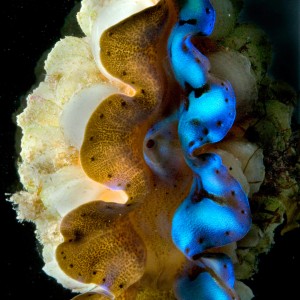Alison Sweeney and her colleagues believe that the reflective structures in giant clams help them grow algae.
“My intellectual lineage is in bio-optics and bio-optical materials, specifically looking at the material properties of biological systems and how they generate new and interesting optical phenomenon.”
Those phenomena are based in a protein called “reflectin,” which is found in a variety of deep-sea squid. The reflectin in the squids’ cells creates a kind of biological reflector with features smaller than the wavelength of visible light—a feat that human technology is only just beginning to replicate in the field of metamaterials. The squid are able to use the reflectin to change the amount of light their bodies reflect as they move into brighter or darker waters, providing them effective camouflage.
Sweeney and her colleagues theorized that reflectin would also be found in a wide variety of related sea life—mollusks—and discovered a fascinating application in a species of giant clams. “The giant clams use these sub-wavelength structures to optimize the photosynthesis of the algae living in their tissues,” she says. “They are essentially farming the algae for nutrients.”
https://penncurrent.upenn.edu/…
Beautiful Science page

